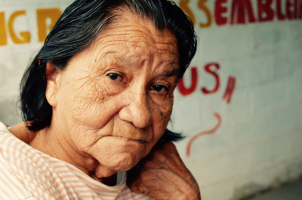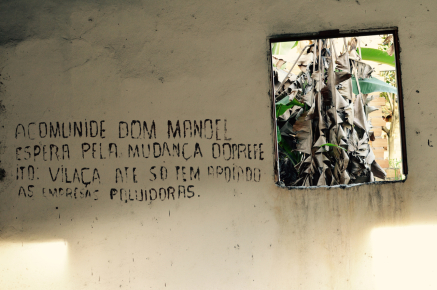
by Diana Aguiar (FASE), Alessandra Cardoso (INESC), and Marcela Vecchione (NAEA/UFPA).
In the airport of Belém in the Amazonian state of Pará, Brazil, an advertisement of the French company Imerys states, “Where you least expect it. Kaolin is a mineral that is part of your day.” The ad tries to tell the story of the positive widespread presence of the mineral in our daily lives. Kaolin is a mineral used in the production of paper, toothpaste, cosmetics and other daily use products.
The sad irony is what the ad hides: how little the communities surrounded by kaolin’s presence in their rivers and soil feel positive about it.
Barcarena is a city close to Belém and is home to the biggest aluminum-industrial center in Latin America. The first industry established in the area was Albras-Alunorte (at the time a project of Japanese capital and of state-owned, now Brazilian-headquartered private corporation Vale) in 1984. The project was part of the global process of relocating polluting and energy-intensive industries to the South. More specifically, it was part of Japan’s decision–in the context of the 1970s oil crisis–to outsource the production of aluminum needed to feed its post-War industrial boom.
The Brazilian military regime embraced the opportunity to host aluminum processing in the Amazon, signing up to huge debts denominated in Japanese yen. It then took on the task of building the energy infrastructure needed for the industry to flourish. The Tucuruí megadam, built in the late 1970s in the Tocantins River, was inaugurated in 1984 and resulted in social and environmental disasters of great proportions. Since then, Tucuruí megadam has been providing energy to the aluminum industry at subsidized rates.
Currently, the refinery Alunorte (Alumina do Norte S.A.) transforms a mineral abundant in the Amazon, bauxite, into alumina. The refinery’s owners are Norsk Hydro, whose main shareholders are the Norwegian state (34,3%), the Norwegian Government Pension Fund (6,81%), and several transnational financial corporations. The factory Albras (Alumínio Brasileiro S.A.) transforms Alunorte’s alumina into aluminum and is owned by Norsk Hydro (51%) and the Japanese consortium NAAC (Nippon Amazon Aluminum Co. Ltd) (49%). Industries in the region also include, amongst others, steel plant Usipar and kaolin processing Imerys Rio Capim Caulim S.A. and PPSA (Pará Pigmentos S.A.).
The high concentration of these industries has turned the area into a “sacrifice zone” for local populations. As is widely known, the whole process of producing aluminum is water-and energy-intensive and is highly air-polluting. While the aluminum makes its way through global value chains, the devastation of the environment—which is the basis of the lives of the surrounding communities—remains. Three decades with the industrial center in Barcarena has meant a rampant population surge in the city due to labour-seeking migration and intense dislocation of traditional peoples and rural populations toward poor slum-like urban areas.
The process of turning Barcarena into an industrial center started during the time of the military dictatorship but continued unabated in the era of post-democratization government planning. It turned the area into an important vector of several trade corridors with hydroways and pipelines transporting kaolin and bauxite. In recent years, continued extractivism and little aggregate value processing of its produce has become part of the economic policy of ensuring continuous trade surplus through the export of commodities.
Social movements have continuously criticized the financial imperatives justifying this “development” model, its environmental devastation, and the role it plays in the increasing dispossession of communities. It was exactly this interconnection between the financialization of the global economy, the “development” policies it entails and its consequent territorial impacts that the Latin American “Financialization of Nature” workshop debated from 26 to 27 August 2015 in Belém do Pará, Brazil.
As part of the workshop process, groups of social activists and researchers took part in caravans that visited communities in the region of Northeast Pará. The caravan we took part visited communities Acuí, Curuperé and Dom Manuel, all of which are facing disintegration of social ties and the never-ending expectation of compensation that could allow them to relocate to a healthy place.
The Acuí community saw its population decrease from 160 to 70 families due to the hardship of living on their land. During our visit, they claimed to be expecting a solution to their situation for the past 12 years, living in a permanent transitory state, including not seeing reasons to make efforts to improve their houses or vegetable gardens due to constant promises that relocation is soon to come. According to them, their soil and bodies are contaminated with heavy metals and their health is jeopardized. They cannot drink water from streams or wells and are dependent on the delivery of water by trucks. Disbelief in any promise and feeling of abandonment by the state were common.
The second visited community, Curuperé, was the living expression of the tragedy of having kaolin as part of your day “where you least expect it”. The stream that served the community was constantly contaminated by infiltrations of kaolin – and heavy metals associated with its industrial processing – from Imerys tailings dams for the past ten years. Where 60 families lived, only 3 remain, now dependent on trucks to deliver water and facing corporate allegations that the land belongs to the corporation. As stories of dispossession usually go, those people saw their territories invaded by the industrial dump of a production process that has nothing to do with their needs and ways of living.
The situation is similar in Dom Manoel, almost a ghost town that saw its population decrease from 164 to 8 families. The families that left before compensation did so due to the impossibility of living in such an environment. The ones that stayed say they have nowhere to go while they await compensation. Imerys claims it has bought the land where these people have been living for decades—taking advantage of the irregularity of land access and ownership—and hence refuses to pay compensation. The community is landlocked by industrial plants in one side and an Imerys tailings dam on the other. Piles of coke used in aluminum processing could be seen meters away from the houses. Even during our short stay, breathing the air caused discomfort.
The three communities, along with several others in the region, have been facing the huge impacts of mineral processing industries. The first serious kaolin leak happened in June 2007. 200,000 m2 of white material discolored 19 km of the river, compromising its use and affecting the water wells. According to studies made of the soil, the leaked material had high concentration of iron, aluminum, zinc and cadmium—these accumulate in the body and may cause degenerative diseases, hepatic dysfunctions, immunological deficiencies, and dementia.
Later that year the Prosecutors Office of the state of Pará and Imerys signed an extrajudicial memorandum of understanding. The TAC (Termo de Ajustamento de Conduta) included commitments to not throw any more toxic substance in the environment, to build up a plan for reparation of the area and restructuring the tailings dams. The financial compensation was directed to collective moral damage to be given to local associations and for the state as compensation for environmental damages and to finance projects to improve peoples lives. However, since then, leaks have continued to happen and communities claim that no reparation of their situation or the environment has occurred.
Shortly after the caravan left Pará, Norsk Hydro announced it was bringing Norwegian pop band A-ha to play in Barcarena. This type of propaganda, as much as the Imerys advertisement, is part of a set of corporate tactics designed to build a narrative that disguises the crude reality lived by the communities we visited. This set of tactics includes the criminalization of those who dare to protest: many people we met are facing criminal charges for fighting for their rights. No wonder there was so much disillusionment. Many of them asked for our help to disseminate the struggles they are going through and the systematic impunity these corporations enjoy. This article is our modest attempt to do so.



